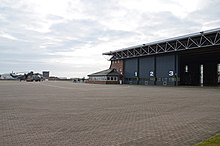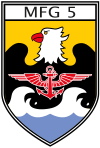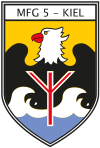Naval Aviation Squadron 5
|
Marinefliegergeschwader 5 |
|
|---|---|
 Internal association badge (coat of arms) |
|
| Lineup | 4th January 1958 |
| Country |
|
| Armed forces |
|
| Armed forces |
|
| Type | squadron |
| Insinuation |
|
| Location |
|
| Awards |
Schleswig-Holstein (1978) |
| guide | |
| Commodore |
Frigate Captain Jan Richard Keller |
| Aircraft | |
|
Fighter aircraft / helicopter |
Westland Sea King Mk.41 Westland Sea Lynx Mk.88A NHI NH90 NTH Sea Lion |
The Marinefliegergeschwader 5 ( MFG 5 ) is a helicopter squadron of the German Navy , which is based at the Nordholz Air Base in the municipality of Wurster North Sea Coast and is subordinate to the Naval Aviation Command.
The squadron is equipped with the Sea King and Sea Lynx helicopters and maintains the SAR service on the North and Baltic Seas. In addition to training its own aircrews, the squadron's training center is also responsible for simulator training for the Portuguese Navy ; for this purpose it operates the Joint Lynx Simulator Training Establishment (JLSTE).
history
| Civilian missions of the MFG 5 | |||
|---|---|---|---|
| 1962 | Storm surge | West Coast | |
| 1962/63 | Ice winter | North Frisian Islands | |
| 1976 | Storm surge | Hamburg and Niederelbe | |
| 1978/79 | Snow disaster | Schleswig-Holstein | |
| 1997 | Flood | Or | |
| 2002 | Flood | Elbe | |
| 2010 | Snow disaster | Rügen - Hiddensee | |
| 2013 | Flood | Elbe | |
On January 1, 1958, frigate captain Heinz Seebens was commissioned to set up a naval aviation association for sea rescue. This took place because the Federal Republic of Germany had joined the International Civil Aviation Organization in 1956 and thus accepted the Agreement on International Civil Aviation (Chicago Agreement) . With this agreement one was obliged to provide a rescue service for air emergencies in their own territory. Since, on the one hand, the financial resources required to set up a civilian rescue service were not available and, on the other hand, the newly founded Bundeswehr had to set up such a service to rescue crews of ships in distress, it was decided to entrust the armed forces with this task.
With the deployment order No. 73 –Marine– , the naval sea emergency unit was set up on January 4, 1958 in Kiel-Holtenau and officially put into service on July 1, 1958. As early as June 1958, four of the ten later Bristol Sycamore helicopters and pilots who had been trained for this purpose in Memmingen were available for this purpose . A year later, five Saunders-Roe Skeeter helicopters were added, as well as eight Pembroke propeller- link aircraft and fourteen Do 27A and B aircraft . At the same time, it had to be renamed the Marine Service and Sea Emergency Group , which at that time consisted of group staff , technical staff and eyrie . For flight operations, the squadron had its own helicopter landing pad ( location ) and the runway at Kiel Airport. The helicopters formed the 1st and the fixed wing aircraft the 2nd flying squadron.
On October 1, the group was renamed the Marine Service and Sea Emergency Squadron , in the meantime there was also the flight operations squadron and the medical and supply squadron, and the year after the squadron for motor vehicles, maintenance and electronics was added. In addition, the Westerland airfield on Sylt was cleared by the British, so that the first branch of the squadron could be opened there.
In 1963, the squadron was reinforced with new Sikorsky S-58 (H-34) helicopters and it got its current name Marinefliegergeschwader 5 . The first squadron of the MFG 4 , which had the task of submarine hunting , was also stationed in Kiel and subordinated to the MFG 5 administratively and technically. The second branch on the North Sea was set up in Borkum in 1964.
To secure the air base, the squadron was provided with a "ground service defense squadron", which since the introduction of the FK 20 was now called the Marine Security Company. In the early 1970s, the Albatros aircraft in the rescue service and the Pembroke aircraft in the transport service were retired and replaced by the Do 28 D-2 Skyservant aircraft. When the last Sikorsky H 34 helicopter was transferred to the German Museum in Munich in 1975 , the Sea King Mk.41 took over the search and rescue service.
In 1986 further tasks were added. Two aircraft of the type DO 28 OU were equipped with sensors that can detect oil pollution. Since then, ships have been identified on the North and Baltic Seas that illegally dispose of their waste oil on the high seas. In 1991 the Do 228 was put into service. In September 1994, flight operations with the Do 28 in Kiel-Holtenau were started and the 2nd flying squadron decommissioned. The two Do 28 OU and the Do 228 LM were handed over to the Naval Aviation Squadron 3 "Graf Zeppelin" .
| Accidents | |||
|---|---|---|---|
| date | Type | Identifier | incident |
| June 14, 1964 | H-23 | SC + 285 | Crash from 20 m, one dead |
| 16. Mar. 1967 | H-34 | WE + 522 | west of Amrum, four dead |
| Sep 7 1968 | H-34 | WE + 576 | North Sea west of Sylt |
| 18th July 1969 | Mk.41 | 89 + 58 | from 10 m, Westerland airfield |
| Jan. 11, 1982 | Mk.41 | 89 + 58 | during the test flight, glider airfield Große Höhe near Delmenhorst |
| March 12 1987 | Mk.41 | 89 + 55 | too hard due to frozen main servo |
| Nov 17, 1998 | Mk.41 | 89 + 59 | dropped during transport across the North Sea for safety reasons |
In 2009, twenty-one Sikorsky Sea King SAR helicopters were in service; MFG 5 was operated by a total of one thousand soldiers and civilian employees.
As part of the realignment of the Bundeswehr , it was decided to relocate MFG 5 from Kiel to Nordholz Air Base . The move started in June 2012 and was completed in November 2012. On August 22, 2012, on the occasion of the move, a farewell reception was held at the Kiel-Holtenau naval air base. The “Fly-Out” from Kiel was carried out on November 6, 2012.
On March 28, 2013 the naval aviators finally said goodbye to the Kiel-Holtenau location with the handover of the key and the federal service flag . Since then, the city of Kiel has been planning a new district on the approximately 92 hectare redevelopment area. Arrived at the Nordholz Air Base, the on-board helicopter squadron 3./MFG 3, previously subordinate to the MFG, switched to MFG 5.
On January 1, 2015, the municipality of Nordholz was incorporated into the newly formed municipality of Wurster North Sea Coast , so that the official location of the squadron has changed. The air base continues to bear the official name "NATO Naval Airfield Nordholz".
An EC 135 has been used for pilot training since 2015 . This civil machine is made available by DL Helicopter GmbH , which also takes care of maintenance. This enables young naval aviators to gain aeronautical experience in the maritime environment with around 800 flight hours per year before continuing their training on the respective weapon system.
According to the Federal Ministry of Defense, the Sea Lynx's operational readiness in the first half of 2016 was 22 percent (4–5 machines), that of the Sea King 29 percent (6 machines).
In autumn 2019, the first of 18 NH90 NTH Sea Lion aircraft arrived in Nordholz to replace the Sea King, which had been in use since the mid-1970s . Flight operations began in June 2020.
structure
After the reorganization of the naval aviation initiated in 2012, the squadron has been structured as follows since 2013.
- Squadron staff
- Flying group
- 1st Flying Squadron (Mk.41, NH90)
- 3rd Flying Squadron (Mk.88)
- Aviation training squadron
- Technical group
- Technical Squadron Mk.41
- Technical Squadron Mk.88
- Technical training relay
Since 2017, MFG 5 has been using the services of HeliOperations in Portland , England , which operates former units of the British armed forces, to provide training support
Commodore
| No. | Surname | Beginning of the term of office | Term expires |
|---|---|---|---|
| 18th | Frigate Captain Jan Richard Keller | June 27, 2019 | constantly |
| 17th | Frigate Captain Mark Wiegand | October 7, 2016 | June 27, 2019 |
| 16. | Frigate Captain Jörg Modey | September 27, 2013 | October 7, 2016 |
| 15th | Frigate Captain Martin Kneip | January 14, 2011 | September 27, 2013 |
| 14th | Frigate Captain Christoph Heck | October 31, 2007 | January 14, 2011 |
| 13. | Frigate Captain Michael Mackenstein | 2005 | October 31, 2007 |
| 12. | Frigate Captain Jens Nemeyer | September 29, 2003 | 2005 |
| 11. | Frigate Captain Klaus Mathew (1) | March 28, 2001 | September 28, 2003 |
| 10. | Sea captain Paul Lutz Helmrich | December 18, 1997 | March 28, 2001 |
| 9. | Sea captain Lothar Politt | August 18, 1993 | December 18, 1997 |
| 8th. | Sea captain Christian Bretschneider | October 1, 1986 | April 30, 1993 |
| 7th | Sea captain Lüppo Schmidt-Smeding | October 1, 1981 | September 30, 1986 |
| 6th | Sea captain Bernd Schäfer | April 1, 1975 | September 30, 1981 |
| 5. | Sea captain Hilmar Schneider | 1st October 1971 | March 30, 1975 |
| 4th | Sea captain Helmut Kampe | May 6, 1970 | September 30, 1971 |
| 3. | Sea captain Wolf Breiding | 1st October 1968 | May 5th 1970 |
| 2. | Sea captain Helmut Schöpke | October 1, 1961 | September 30, 1968 |
| 1. | Frigate Captain Heinz Seebens (2) | 4th January 1958 | August 16, 1958 |
Squadron coat of arms
The squadron coat of arms contains the elements water, sea eagle, anchor and wing. The white-tailed eagle watches over the troubled sea. Belonging to the naval aviators is symbolized by a swing arm and anchor.
The coat of arms was the basic features of Staff Bosun designed Fritz Safert. In the original coat of arms, the eagle had a black head and looked to the right when viewed from the viewer. The feathery wings were drawn straight. There was a blue and a white wave each and in the center there was a rune of life without a white border. It was symbolic of all the lives that the eagle saved from death and danger. The life rune was already used by the rescue pilots in World War II . Up to the present coat of arms it went through four changes. In 1962 the waves were stylistically improved and replaced by two white waves with spray and four rounded blue waves. The eagle's line of sight was also changed. On the occasion of the 1972 Olympic Games in Kiel, the eagle was given a more dynamic expression thanks to the wings that are now raised inwards. On the open day in 1975, the coat of arms was given its final form by a graphic designer from the United Flight Technical Works at the time when the MFG 5 was located in Kiel. The black eagle became a sea eagle with a feathered white head, depending on the area of operation. After moving to Nordholz, the rune of life was replaced in 2013 by a swing arm and anchor and the reference to keel in the upper white field was removed.
Web links
- Official website of the Naval Aviation Squadron 5
- History of the German sea and naval pilots on seeflieger.de
Individual evidence
- ↑ Achim Winkler: A serenade to say goodbye. Bundeswehr, Marine Press and Information Center, August 24, 2012, accessed on October 10, 2013 .
- ↑ “Fly In” in Nordholz - Arrival of the “Sea King” at the new location. Bundeswehr, Marine Press and Information Center, November 7, 2012, accessed on October 12, 2013 .
- ↑ The end of an era . ( Memento from April 2, 2015 in the Internet Archive ) Kieler Nachrichten , March 28, 2013
- ↑ Holtenau Ost redevelopment area. kiel.de, accessed on June 16, 2017 .
- ^ NATO naval airfield Nordholz. In: Bundeswehr location database . www.zmsbw.de, accessed on April 13, 2020 .
- ^ Sophie Fiebeler, Kim Brakensiek: Training helicopter EC-135 flies for the Navy. Bundeswehr, Marine Press and Information Center, April 10, 2015, accessed on September 10, 2016 .
- ↑ Bundeswehr improves operational readiness of their helicopters. In: Süddeutsche Zeitung. dpa, August 9, 2016, accessed on August 3, 2020 .
- ↑ Roland Voigt: Transport helicopter: Introduction of the "sea lion". Bundeswehr, June 3, 2016, accessed on September 10, 2016 .
- ↑ Marine puts new helicopters into operation. NDR, June 9, 2020, accessed June 10, 2020 .
- ↑ Why Sea Kings still rule for HeliOperations. Flightglobal, July 17, 2020
- ↑ Navy helicopters get a new commodore. Bundeswehr, Marine Press and Information Center, October 4, 2016, accessed on October 8, 2016 .
- ↑ Overview of changes in leadership in the Navy. Bundeswehr, Marine Press and Information Center, October 2, 2013, accessed on October 10, 2013 .
- ↑ Transfer of command to the naval aviation in Kiel-Holtenau ( Memento from October 9, 2016 in the Internet Archive )
- ↑ Change of command in Naval Aviation Squadron 5 Frigate Captain Michael Mackenstein hands over his command to Frigate Captain Christoph Heck. Bundeswehr, Marine Press and Information Center, October 29, 2007, accessed on October 8, 2016 .
Coordinates: 53 ° 46 ′ 5 " N , 8 ° 39 ′ 43.4" E




